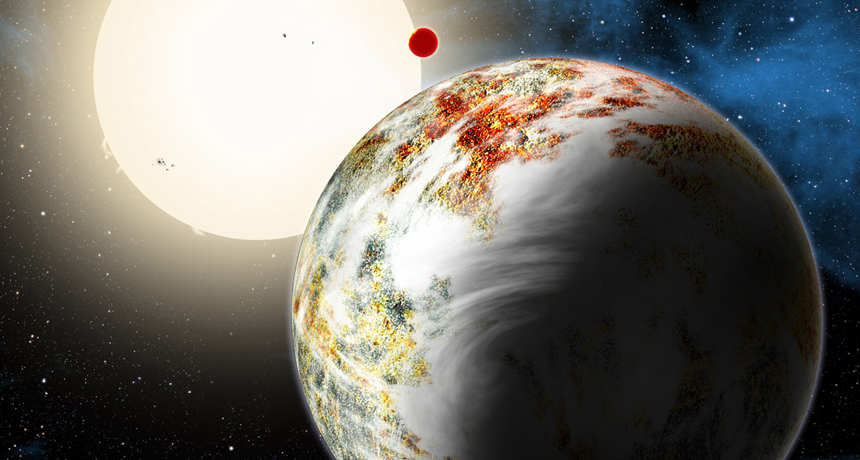First mega-Earth found
This huge, rocky exoplanet upends astronomers' ideas about how planets form

Artist's drawing shows Kepler-10c (in right foreground), the biggest rocky exoplanet known. Astronomers used to think such big, solid worlds couldn’t form.
DAVID A. AGUILAR/CFA
The giant exoplanet, Kepler-10c, doesn’t play by the rules. It has as much mass as Neptune — yet it’s made of rock, just like Earth. Astronomers are now calling it a “mega-Earth.” Our solar system’s massive planets, such as Jupiter and Saturn, are made from gas. And scientists used to think any planet that massive must also be made primarily of helium and hydrogen. But Kepler-10c is now forcing experts to throw such assumptions out the window.
Kepler-10c is one of two planets orbiting a sunlike star 564 light-years away. It sits in the constellation Draco. Although as massive as Neptune, this heavyweight is only 2.5 times as wide as Earth. (Neptune’s diameter, for comparison, is nearly 4 times that of Earth’s.) So Kepler-10c is dense and its gravity exceptionally strong — about three times stronger than Earth’s, explains David Latham. He’s an astronomer at the Harvard-Smithsonian Center for Astrophysics in Cambridge, Mass. Latham shared his team’s findings June 2 at an astronomy meeting in Boston.
All that mass would give the exoplanet extreme gravity, the researchers note. Kepler-10c also orbits close to its star — so close that it completes an orbit in only 45 days. This proximity to its sun means the planet’s climate also should be brutally hot. (A companion planet, called Kepler-10b, orbits even closer and faster. Earth, by comparison, takes a little more than 365 days to complete one orbit of the sun.)
Kepler-10c was one of the first exoplanets found by the Kepler space telescope. The robotic space mission has been searching for planets beyond our solar system since 2009. Astronomers measured the size of Kepler-10c three years ago. But until now, they didn’t realize its heft.
To measure the mass of an exoplanet, astronomers focus on its sun. A star’s gravity keeps a planet moving in orbit, like Earth moves around our sun. But a planet’s gravity also tugs on the star — and causes the star to wobble. The more mass a planet has, and the closer it is to the star, the more it makes that star wobble. By measuring this stellar wobble, scientists can estimate a planet’s mass. That’s what Latham and his colleagues did with Kepler-10c.
Once they had measured its mass and size, the scientists determined the planet’s density. Density is calculated by dividing mass by volume. Rocky planets are dense: They pack a lot of stuff into a small space. Gas giants aren’t: They are large and fluffy. Latham and his team have now determined that Kepler-10c has the density of rock.
The planet weighs 17 times as much as Earth. Astronomers used to think that planets with at least 10 times the mass of Earth had to be gas giants. As Kepler-10c now shows, that’s not always true. Astronomers have no idea how the rule-breaking planet formed.
Even though Kepler-10c is the only mega-Earth known, it’s probably not the only one out there.
“When one type of planet is found, that’s usually the tip of the iceberg,” says Sara Seager. She’s an exoplanet hunter at the Massachusetts Institute of Technology, in Cambridge, who did not work on the new study. “There are probably many, many more of them,” she says of mega-Earths.
Power Words
astronomy The area of science that deals with celestial objects, space and the physical universe as a whole. People who work in this field are called astronomers.
density A measure of the consistency of an object, found by dividing the mass by the volume.
diameter The length of a straight line that runs through the center of a circle or spherical object, starting at the edge on one side and ending at the edge on the far side.
exoplanet A planet that orbits a star outside the solar system.
galaxy A massive group of stars bound together by gravity. Galaxies, which each typically include between 10 million and 100 trillion stars, also include clouds of gas, dust and the remnants of exploded stars.
gravity The force that attracts anything with mass, or bulk, toward any other thing with mass. The more mass that something has, the greater its gravity.
helium An inert gas that is the lightest member of the noble gas series. Helium can become a solid at -458 degrees Fahrenheit (-272 degrees Celsius).
hydrogen The lightest element in the universe. As a gas, it is colorless, odorless and highly flammable. It’s an integral part of many fuels, fats and chemicals that make up living tissues.
mass A number that shows how much an object resists speeding up and slowing down — basically a measure of how much matter that object is made from.
orbit The curved path of a celestial object or spacecraft around a star, planet or moon. One complete circuit around a celestial body.
solar system The eight major planets and their moons in orbit around the sun, together with smaller bodies in the form of dwarf planets, asteroids, meteoroids and comets.
stellar An adjective that means of or relating to stars.
telescope A light-collecting instrument that makes distant objects appear nearer through the use of lenses or a combination of curved mirrors and lenses. Some, however, collect radio emissions (energy from a different portion of the electromagnetic spectrum) through a network of antennas.







